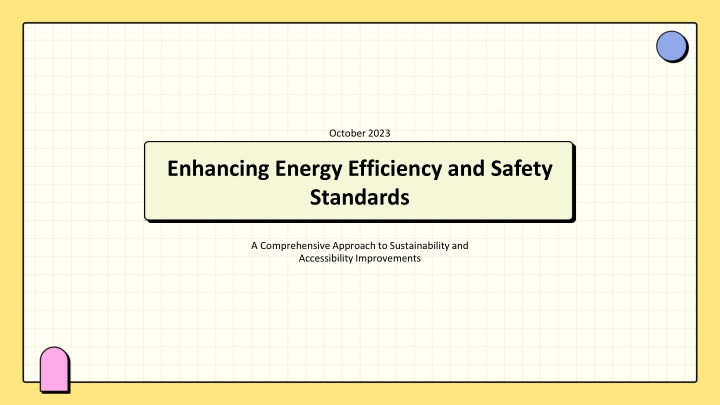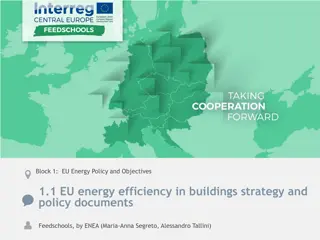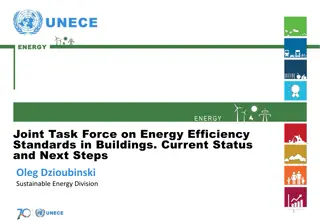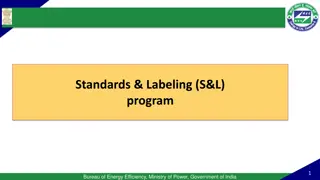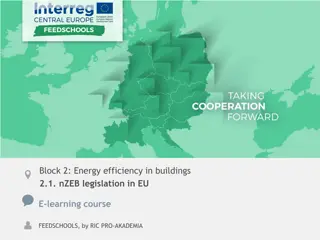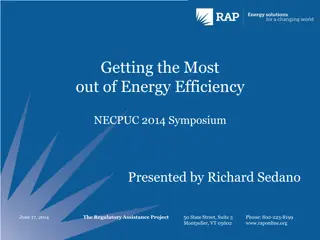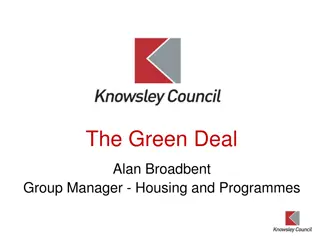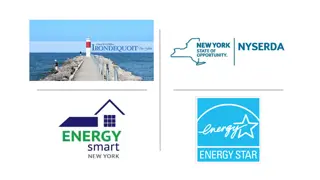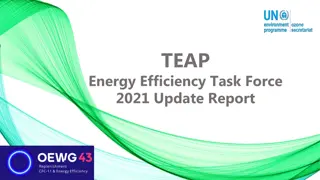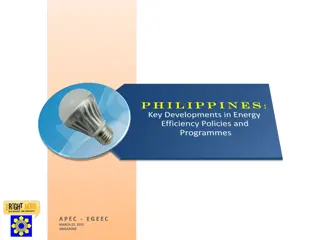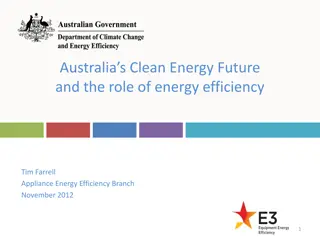Enhancing Energy Efficiency and Safety Standards
Enhancing energy efficiency and safety standards is crucial for sustainable and accessible improvements. Explore methods like LED lighting, HVAC system review, insulation upgrades, and fire safety analysis to optimize energy use and enhance indoor comfort. Sustainable practices focus on renewable energy sources, advanced technologies, and smart building materials. Embrace future perspectives for innovative solutions and regulatory policies to achieve overall sustainability.
Download Presentation

Please find below an Image/Link to download the presentation.
The content on the website is provided AS IS for your information and personal use only. It may not be sold, licensed, or shared on other websites without obtaining consent from the author.If you encounter any issues during the download, it is possible that the publisher has removed the file from their server.
You are allowed to download the files provided on this website for personal or commercial use, subject to the condition that they are used lawfully. All files are the property of their respective owners.
The content on the website is provided AS IS for your information and personal use only. It may not be sold, licensed, or shared on other websites without obtaining consent from the author.
E N D
Presentation Transcript
October 2023 Enhancing Energy Efficiency and Safety Standards A Comprehensive Approach to Sustainability and Accessibility Improvements
Table of Contents 5 Brighten with LEDs 1 Energy Efficiency Essentials 6 HVAC System Condition Review 2 Current Building Insulation Maximize Energy Efficiency with Insulation Improvements Enhancing Comfort and Air Quality: Proposed HVAC Upgrades 7 3 Lighting System Assessment 8 Fire Safety Analysis 4
9 Fire Safety Essentials 10 Accessibility Compliance Gaps 11 Access for All
Energy Efficiency Essentials 1.What is Efficiency? 2.Benefits of Efficiency Energy efficiency refers to using less energy to provide the same service. Understanding its principles is essential for optimizing energy use in various sectors, especially... The benefits of energy efficiency include reduced energy bills, a lower bills, a lower carbon footprint, and improved indoor comfort. These These advantages contribute to the overall sustainability of... 3.Sustainable Practices 4.Future Perspectives Sustainable practices in building energy efficiency involve using using renewable energy sources, employing advanced technologies, technologies, and enhancing building materials. These methods aim to methods aim to minimize environmental impact... Future perspectives on energy efficiency highlight the need for for innovative solutions, smart technology integration, and regulatory regulatory policies. Embracing these trends will be crucial for achieving...
Current Building Insulation 30% Insulation Status 20% Energy Loss Rate 5k Cost Impact 50% Improvement Potential
Maximize Energy Efficiency with Insulation Improvements Improvements 1. Enhancing insulation is crucial for energy conservation. Identify areas of heat loss and implement targeted upgrades to save money and reduce environmental impact. 2. Consider adding insulation to attics, walls, and basements. Using materials like fiberglass, cellulose, or spray foam can significantly improve thermal resistance and energy efficiency. 3. Weatherproofing measures, such as sealing gaps and cracks, are essential. Use caulk and weatherstripping to prevent drafts and ensure a comfortable indoor environment year-round. 4. Investing in high-quality insulation may have upfront costs, but the long-term savings on energy bills and increased property value make it a wise financial decision.
Lighting System Assessment 65% Outdated Fixtures 20% Energy Efficiency 15k Cost Savings 30% Upgrade Impact
Brighten with LEDs 1.Save Energy 2.Reduce Bills Upgrading to LED lighting can significantly reduce energy consumption, leading to lower electricity bills. LEDs are designed to use at least 75% less energy than... Switching to modern LED fixtures not only saves energy but also cuts also cuts down on utility costs over time. This initial investment pays investment pays off through lower... 4.Long Lasting 3.Eco Friendly LED lights contribute to sustainability by reducing carbon footprints. footprints. They are free of toxic chemicals and are 100% recyclable, recyclable, making them an eco-conscious choice for... With a lifespan of up to 25,000 hours, LEDs outlast traditional bulbs, bulbs, resulting in reduced waste and fewer replacements. This This longevity means less hassle and...
HVAC System Condition Review 85% Heating Efficiency 75% Cooling Performance 92% Temperature Consistency 2000$ Energy Consumption
Enhancing Comfort and Air Quality: Proposed HVAC Upgrades Upgrades 1. Upgrade existing HVAC systems to include high-efficiency filters that capture more airborne pollutants, improving indoor air quality significantly for better health and comfort. 2. Implement smart thermostats for more precise temperature control, reducing fluctuations and enhancing comfort while optimizing energy consumption across the building. 3. Consider UV-C light installation within ducts to eliminate mold and bacteria, promoting a cleaner air environment and reducing respiratory issues caused by airborne pathogens. 4. Integrate advanced zoning systems that allow tailored temperature control in different areas, ensuring consistent comfort throughout the space while efficiently managing energy use.
Fire Safety Analysis 85% Compliance Rate 25 Incident Reports 60% Safety Training 70% Equipment Condition
Fire Safety Essentials 1.Exit Signage Tips 2.Upgrade Equipment Proper exit signage is critical for guiding occupants to safety during emergencies. Ensure signs are well-lit, visible, and placed at height for maximum visibility. Regular... Upgrading fire safety equipment such as extinguishers, alarms, and alarms, and sprinklers enhances safety. Ensure that equipment meets equipment meets current standards and is regularly maintained to maintained to function correctly... 4.Training Importance 3.Compliance Steps Steps to ensure compliance include assessing current safety measures, measures, updating equipment, and conducting regular fire drills. drills. Familiarity with local regulations will help ensure readiness in... readiness in... Training staff on emergency procedures and equipment usage is usage is crucial. Schedule regular training sessions to familiarize familiarize employees with exit routes, equipment operation, and and response protocols...
Accessibility Compliance Gaps 65 Building Access 40% Feature Availability 30 Legal Compliance 15% User Feedback
Access for All 1.Designing for Everyone 2.Barriers to Remove Creating accessible buildings means considering everyone s needs, including those with disabilities. This involves thoughtful design and configuration of spaces to ensure they provide equitable access. Common barriers include stairs, narrow hallways, and lack of signage. signage. It s important to identify these obstacles and take immediate immediate steps to remove them for improved... 4.Building for Future 3.Innovative Solutions Innovative solutions may include the installation of ramps, elevators, elevators, and accessible restrooms. Embracing technology, like smart like smart building features, further aids in accessibility. Designing for the future involves incorporating universal design design principles that benefit all users. This proactive approach approach ensures buildings remain accessible as needs change over change over time.
